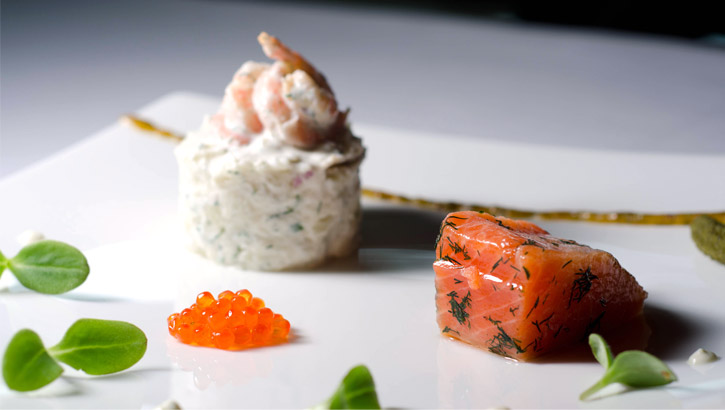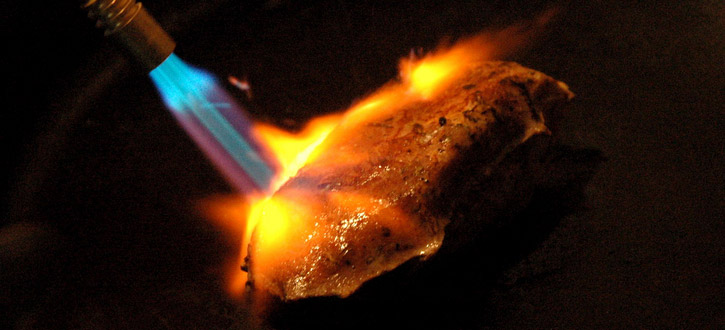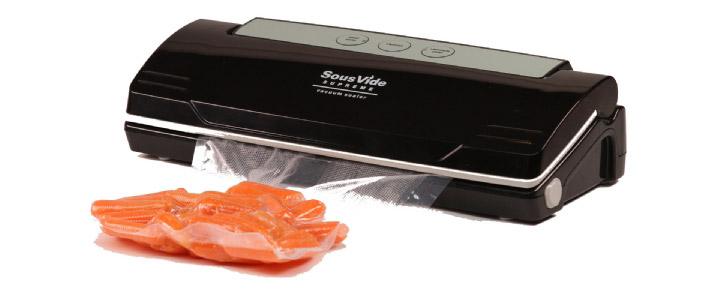Preparing Food for Sous Vide Cooking
Portioning Food for Sous Vide
We generally recommend cutting food into small serving sizes whenever possible for sous vide applications so the center of the food reaches desired temperature faster. There are two reasons for this:
Reduced cooking time
This is important for delicate foods such as fish and very tender cuts that will become mushy or pappy if held too long in the bath. The smaller the food piece, the faster its center will reach final cooking temperature. Tough cuts (of intact muscle) can be left in larger portions since they benefit from longer cooking times (and the interior of intact muscle meat is generally considered sterile).
If you were to cook and hold a piece of beef at 140°F/60°C in a sous vide bath for, say, an hour or two after its center has reached final cooking temperature, it would be virtually indistinguishable from beef held at that temperature for just 15 minutes. That's because the heat, besides cooking the meat, doesn't have time to make any significant changes to the structure of the beef---over time the connective tissue in the muscle would eventually weaken, but such a change might take days at such low temperatures.
Fish is different. Fish can go mushy when held at relatively low temperatures for just minutes too long. So fish should be removed from the sous vide bath as soon as its center reaches target temperature but beef could be held in the bath for several hours until you are ready to serve it.
In the below recipe for Table Smoked Tasmanian Ocean Trout, the star fish is cooked sous vide for just 20 minutes at the low temperature of 109°C/43°C.

Staying out of the danger zone
Another reason to cook small portions is to avoid leaving areas of a large piece of meat in the "danger zone" of microbial spoilage for too long. The general rule of thumb is to avoid leaving food in the temperature range from 40°F/4°C to 140°F/60°C for any extended period.
For example, if you were planning to cook a cut of pork to 150°F/65°C, you could hold it in the sous vide bath for hours safely. But if the cut was so large that the heat of the water bath didn't effectively penetrate throughout, there could be zones in your product that would stay well under 140°F for hours, increasing risk of microbial spoilage.
Searing food before cooking sous vide
One of the hallmarks of a great steak is the beautiful brown sear on its outside. This flavorful, crispy skin gives the steak most of its flavor and can only be achieved at high temperature.
Since sous-vide cooking never reaches high temperatures, you must always sear sous-vide cooked meat separately to achieve excellent browned flavor. Searing before cooking a piece of meat sous vide has several benefits.
- Pre-searing kills most of the microbes on the surface of the meat, making cooking sous vide safer.
- Searing the meat before sous vide cooking, allows the created flavor compounds to penetrate the meat during the sous vide process.
- Pre-searing when the meat is cold, reduces the chances of overcooking beyond the edge.
- Pre-searing firms soft meats and seafood so they hold their shape better when vacuum packing.

Now, the disadvantage of pre-searing the meat is that most foods will have to be seared again after they are cooked sous vide. Cooking a seared piece of meat sous vide will usually soften the crust that builds on its outside after searing. To restore the crust, sear the meat right before serving. If the food was pre-seared, the final searing process will be quicker and will reduce the chances of overcooking beyond the edge. Fish and seafood can usually be just pre-seared since a crust is not necessary in most cases.
Searing lamb before cooking sous vide is not recommended as it causes unpleasant flavors generated by unwanted reactions while cooking sous vide for long times. Be aware that the same effect may happen with other grass-fed animals.
Learn more about searing techniques at Finishing Food After Cooking Sous Vide.
Blanching food before cooking Sous Vide
It is generally recommended to blanch fruits and vegetables before cooking sous vide to preserve the color and texture. Bring water to boil and deep the fruits and vegetables for 2 seconds to destroy the enzymes that cause browning.
Blanching can also be used with meat and seafood. If you are not pre-searing, you can blanch them to kill bacteria on the surface and firm them up so they hold their shape when vacuum packing.
Salting food before cooking sous vide
Any good home chef would tell you that it's always better to salt meat before cooking: the salt penetrates into the meat and helps to tenderize and flavor the entire cut.
Sous vide, however, doesn't work that way.
If you salt food before cooking it sous vide, holding the food at low temperature for a long time inadvertently cures the food, resulting in a dense, pickled texture.
When cooking sous vide, it is therefore generally better to add salt after the sous vide cooking phase, unless you're intentionally trying to create a cured texture. Salting a steak before cooking sous vide is only recommended when it’ll be served immediately. If what you're cooking will be served immediately, then you may want to add seasoning or a marinade before vacuum sealing.
Seasoning before cooking Sous Vide
You can add dry or liquid condiments to the food before vacuum packing. Herbs, marinades, spices, lemon slices, etc. will infuse into the food while cooking sous vide. Use less quantity than you would when cooking traditionally because flavors will be more intense thanks to the vacuum packing and the long cooking time at warm temperatures.
When using a clamp-style vacuum sealer, liquids will get sucked into the machine. To avoid this, freeze any seasoning liquids before placing them in the bag for vacuum packing. Vacuum chambers are expensive but they can handle liquids without any problems.
Smoking before cooking Sous Vide
When cooking sous vide and you want to smoke the food, it may be better to do it before cooking it.
- Uncooked meat will react with the smoke easier than cooked meat.
- The aromas generated during the smoking process will penetrate the cut during the sous vide cooking process.
- Starting with a cold cut minimizes the risk of overcooking the meat while smoking.
However the smoke taste will be milder than if smoked after cooking sous vide.
Cooking Sous Vide from frozen
You can cook food sous vide that is frozen without having to thaw it first. You will just have to add 30 min to 1 hour to cooking times to allow the food to thaw in the sous vide water bath.
Bagging foods for sous vide cooking
We've already discussed the fact that you don't need a vacuum sealer to cook sous vide, although you might benefit from using vacuum bags for some applications and there are several benefits to vacuum sealing.
- Vacuum-sealing allows for efficient heat transfer from the water (or steam) to the food.
- It prevents evaporative losses of flavor volatiles and moisture during cooking. Enclosed spices and ingredients added transmit their flavor more intensely. It retains all juices from proteins.
- It helps inhibit off-flavors from oxidation. For example, fat in meat can become rancid when exposed to air for a long time.
- It increases shelf-life by eliminating the risk of re-contamination during storage if food is going to be cooked, stored and reheated.

Special vacuum bags can be useful for large batches or for awkwardly-shaped items that don't fit into normal zip-top bags. Vacuum sealing material also tends to be thicker than zip-top bags, which can help prevent leaks and tears, especially at high temperatures. Vacuum sealing is ideal for cooking a product and then freezing it for long storage.
Some folks at home have raised concerns over whether the plastic in vacuum bags or in standard zip-top bags can handle the high heat of sous vide cooking. An in-depth analysis of safety concluded that both vacuum bags designed for sous vide and Ziploc brand bags sold in the United States are safe to use for sous vide.
For those of you who would prefer not to use and throw away plastic bags on a regular basis, consider this reusable silicone bag.
You can learn more about using a vacuum sealer for sous vide at our sous vide equipment guide.
For more on cooking sous vide without a vacuum machine, see this primer at Cooking Issues.
Parts of this course were adapted from Sous Vide Cooking: An Introduction by Douglas Baldwin





